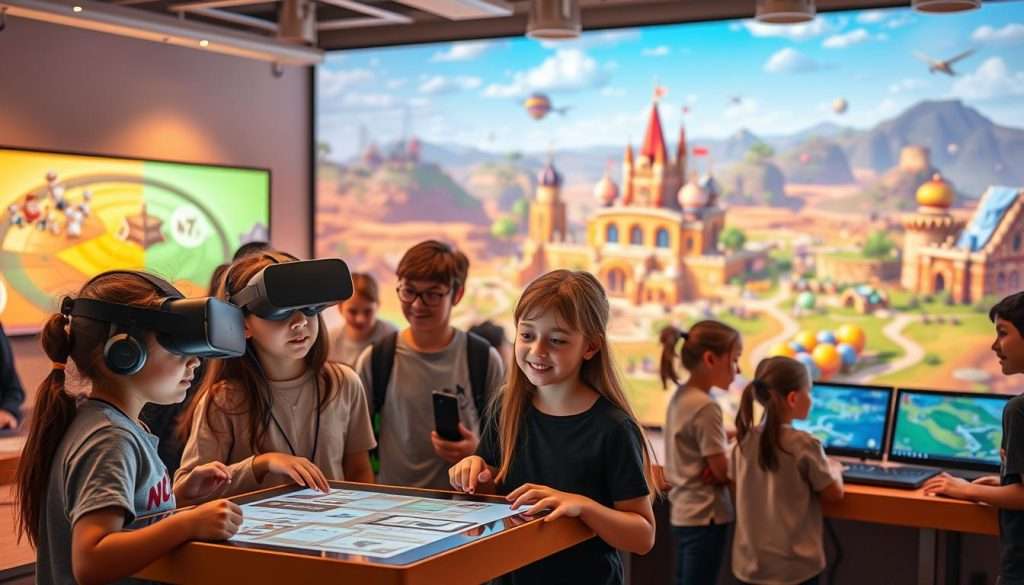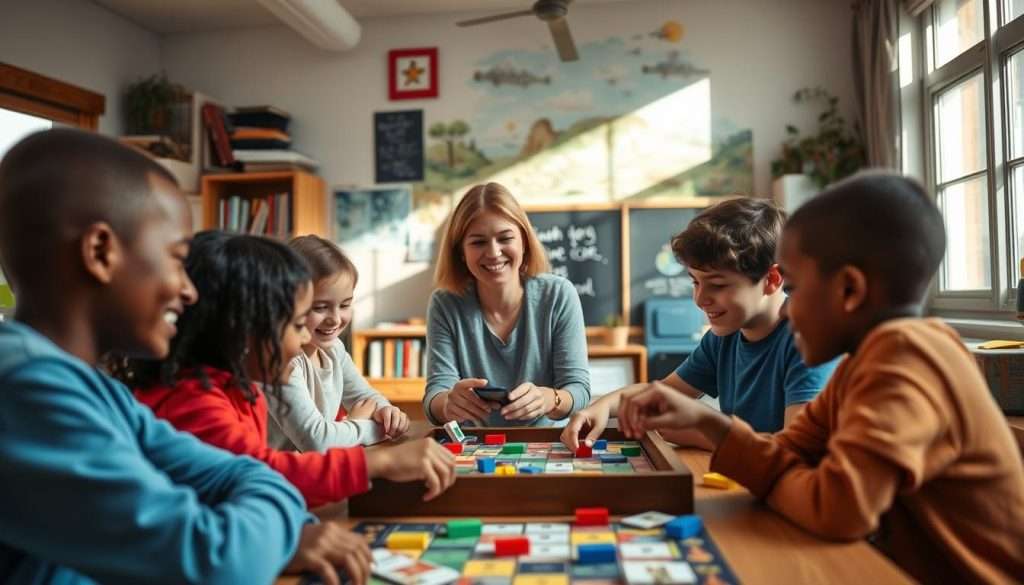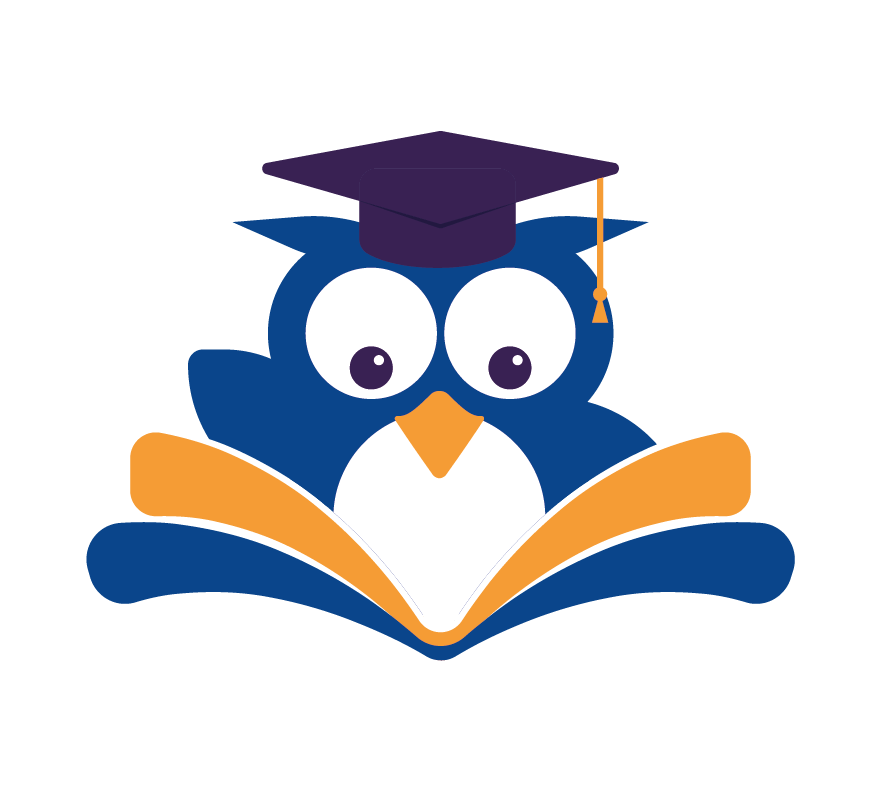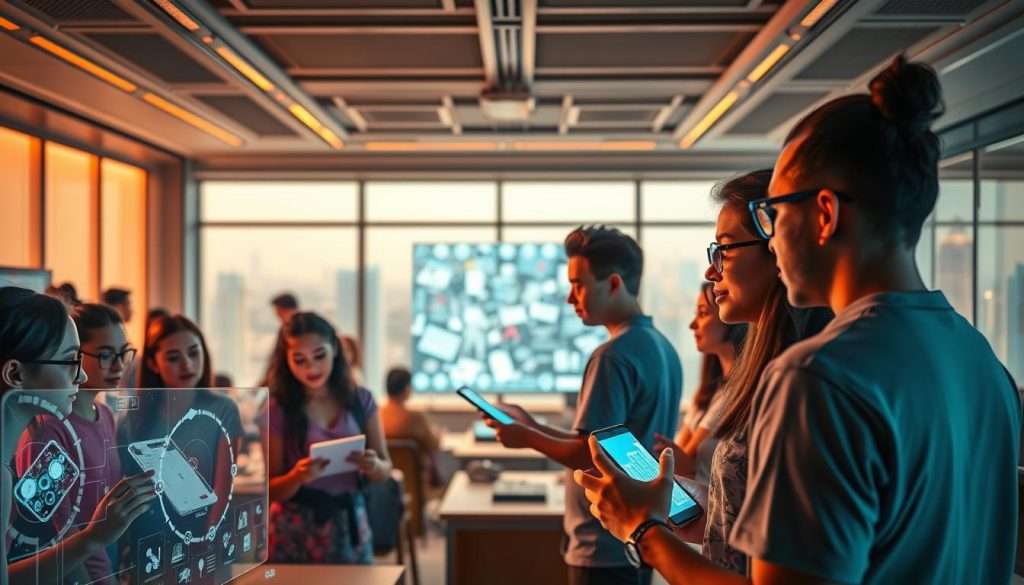We’re on a mission to change how we learn. Imagine being so into learning that you forget you’re studying! Gamification is making learning fun, interactive, and motivating.
Gamification uses our psychological drivers to keep us on track and reaching our goals. It’s not just about getting rewards or badges. It’s about feeling a sense of accomplishment and pride in our work. When we make learning fun, we’re more likely to keep going and reach our full potential.
Key Takeaways
- Discover how gamification can boost your motivation to learn.
- Learn how to make learning a fun and interactive experience.
- Unlock your full potential by tapping into your psychological drivers.
- Transform your study routine into an engaging adventure.
- Achieve your goals with a sense of accomplishment and pride.
What Is Gamification in Learning?
Learning through gamification uses game design to make education better. It adds game elements like rewards and challenges to learning. This makes education more fun and interactive.
The Psychology Behind Gamification
Gamification taps into human behavior, especially the release of dopamine and goal achievement motivation.
Dopamine and Reward Circuits
Dopamine, a pleasure neurotransmitter, is key in gamification. When learners hit milestones or finish challenges, they get a dopamine boost. This reward strengthens positive actions.
Studies show this reward system is vital in keeping people interested in learning.
| Psychological Aspect | Role in Gamification |
|---|---|
| Dopamine Release | Reinforces positive behavior through pleasure |
| Motivation Through Achievement | Encourages continued engagement through goal attainment |
Motivation Through Achievement
Reaching goals and beating challenges motivates deeply. Gamification uses this by setting clear goals and rewarding success. This keeps learners engaged for a long time.
The Science-Backed Benefits of Gamified Learning
Adding game elements to learning boosts motivation and keeps knowledge fresh. This isn’t just a guess; it’s proven by science. Gamified learning uses psychology to make learning fun and effective.
Increased Motivation and Engagement
Gamification uses our love for competition and rewards to keep us engaged. Educational games use points, badges, and leaderboards to push learners forward.
Case Study: Language Learning Apps
Apps like Duolingo keep users hooked. Duolingo uses daily goals, streaks, and rewards to keep users coming back. A study found that Duolingo users stick around 45% of the time after a year.
“Gamification is not just about making learning fun; it’s about making it effective.”
Enhanced Knowledge Retention
Game-based learning is more than just fun; it boosts memory too. Interactive experiences help us remember better.
Research on Game-Based Memory Improvement
Research shows games can improve memory by up to 20%. Games make us recall information in context, helping us remember better.
| Learning Method | Retention Rate |
|---|---|
| Traditional Learning | 40% |
| Game-Based Learning | 60% |
Adding game elements to learning boosts both motivation and memory. By understanding gamified learning, we can change education for the better.
How to Gamify Your Learning: Core Principles
To make learning fun, you need to know the basics. Gamification is more than just making things enjoyable. It’s a smart way to make learning better.
Setting Clear Goals and Objectives
Clear goals are key to gamifying your learning. Knowing what you want to achieve helps you stay on track. It keeps you motivated.
SMART Goals in Learning Games
SMART goals make learning games more effective. For example, instead of saying “I want to learn Spanish,” aim for “I will learn 100 new Spanish words every week for the next month.”
Creating Reward Systems
Reward systems are vital in gamifying learning. They give you motivation and a feeling of success. You can use badges, points, or even treats as rewards.
Immediate vs. Delayed Gratification
Think about both immediate and delayed rewards. Instant rewards motivate you right away. But, saving up for a bigger reward later can keep you committed for longer. For example, earn a badge now, but save points for a bigger reward later.
By using these principles, you can make learning fun and effective. The most important thing is to make these strategies fit your own learning style.
Gamification Techniques for Different Learning Styles
People learn in different ways, and gamification can help. It makes learning fun and effective for everyone. By using various techniques, we can engage all learners.
Visual Learners: Maps and Visualization Tools
Visual learners do well with maps and visualization. Mind mapping is a great tool that can be made into a game. This makes learning more fun and interactive.
Mind Mapping as a Game
Mind mapping uses colors, symbols, and images to connect ideas. To make it a game, try to create the best map in a set time. Or, challenge others to do the same.
| Technique | Description | Benefit |
|---|---|---|
| Mind Mapping | Visual representation of information | Enhances creativity and organization |
| Timed Challenges | Creating maps within a time limit | Increases speed and efficiency |
Auditory Learners: Sound-Based Challenges
Auditory learners enjoy sound-based challenges. These make learning fun and engaging.
Musical Memory Techniques
Music can help with memory. Create songs or rhymes to remember important information. This makes it easier to recall during tests or exams.

By using different gamification techniques, we can make learning better for everyone. Whether you’re a visual, auditory, or kinesthetic learner, there’s a way to help you succeed.
Digital Tools to Gamify Your Learning
Now, making learning fun is easier than ever. You can find many digital tools to help. These apps and platforms make learning fun and engaging.
Learning Apps with Gamification Features
Many learning apps use games to keep you interested. They make learning fun and interactive.
Duolingo, Kahoot, and Quizlet
Duolingo, Kahoot, and Quizlet lead in making learning a game. Duolingo rewards you as you learn new languages. Kahoot lets teachers create quizzes and games for a fun learning environment. Quizlet uses flashcards and games to help you remember new things.
“Gamification in education is not just about making learning fun; it’s about making it effective,” say educators. They’ve seen great results using these tools.
Gamified Learning Platforms
There are also big platforms for gamified learning. They cover many subjects.
Codecademy, Khan Academy, and Brilliant
Codecademy, Khan Academy, and Brilliant offer fun learning in coding and math. Codecademy teaches programming with real projects. Khan Academy has many courses with challenges and badges. Brilliant uses problems to teach STEM subjects in a fun way.
Using these digital tools can really improve your learning. They make learning fun and effective. Exploring these options shows that gamifying your learning is both enjoyable and effective for reaching your goals.
Analog Methods: Gamifying Learning Without Technology
You don’t need a smartphone to make learning fun. Analog methods can be just as good. By adding game design to daily learning, we can make it engaging and interactive, all without technology.
Board Games and Card Systems for Learning
Board games and card systems are great for learning. They promote social interaction, strategic thinking, and friendly competition. For example, Scrabble can boost your vocabulary and spelling. Meanwhile, Math War makes math practice fun.
Educational Board Game Recommendations
- Ticket to Ride: Improves geography knowledge and planning skills.
- Settlers of Catan: Enhances resource management and negotiation.
- History of the World: Teaches historical events and cultural knowledge.

Role-Playing and Simulation Techniques
Role-playing and simulation are strong analog methods for learning. They let learners dive into real-world scenarios, making learning more relatable and memorable. Educators can use these techniques to help students think critically and solve problems.
Creating Learning Scenarios
To create effective learning scenarios, first identify what you want to teach. Then, design a scenario that fits these goals, encouraging learners to engage deeply with the material. For instance, a mock business meeting can teach negotiation and leadership. A simulated historical event can make history come alive.
By using analog methods in our learning, we can engage with learning games in a more varied and interactive way. This makes learning more enjoyable and effective.
Integrating Social Elements: Learning with Others
Learning together opens up new possibilities. Adding social elements to our learning makes it more fun and effective. This way, we create a lively learning space that encourages teamwork and support.
Collaborative Learning Games
Collaborative learning games boost teamwork and communication. They help us solve problems together and learn from each other’s strengths.
Team-Based Challenges
Team-based challenges are great for teamwork. Working together towards a goal builds friendship and makes learning more enjoyable.
Competitive Challenges That Enhance Learning
Competitive challenges can be good if done right. They motivate us to do better and reach higher goals.
Healthy Competition Frameworks
A healthy competition framework keeps the focus on learning. It creates a positive and supportive atmosphere.
| Social Element | Benefits |
|---|---|
| Collaborative Learning | Enhances teamwork and problem-solving skills |
| Competitive Challenges | Boosts motivation and performance |
Overcoming Challenges in Learning Gamification
Using gamification in learning comes with its own set of challenges. We aim to gamify your learning but face obstacles along the way. Let’s tackle these common hurdles to move forward.
Maintaining Long-Term Motivation
Keeping learners motivated for a long time is a big challenge. We can solve this by changing up the challenges and rewards. This keeps the learning experience exciting and new.
Preventing Burnout and Boredom
To avoid burnout, we need to balance hard tasks with breaks. Adding different learning activities, like interactive learning games and quizzes, helps a lot.
Balancing Fun with Educational Value
Making learning fun is key, but we mustn’t forget the educational part. It’s important to find a good balance between fun and learning.
Ensuring Learning Outcomes
To make sure we meet our learning goals, we track progress and adjust our strategy. Here’s how we can balance different gamification elements:
| Gamification Element | Fun Factor | Educational Value |
|---|---|---|
| Points System | 8/10 | 6/10 |
| Interactive Quizzes | 7/10 | 9/10 |
| Leaderboards | 9/10 | 5/10 |
By facing these challenges head-on and finding solutions, we can make learning more fun and effective. As we keep gamify your learning, we’ll reach our educational goals better.
Measuring Success: Tracking Your Gamified Learning Progress
Measuring success in gamified learning needs a careful plan. You must set and track important metrics. As you use educational games in your learning, it’s key to see how well they work.
Setting Meaningful Metrics
To measure your gamified learning success, you need clear goals. This means using both numbers and feelings to judge your progress.
Quantitative and Qualitative Measures
Numbers like points earned, levels reached, or time spent are quantitative. Qualitative measures look at how engaged and happy you are with game-based learning.
Tools for Progress Tracking
Many tools can help you keep track of your gamified learning. These range from digital apps to old-school paper methods.
Digital and Physical Tracking Methods
Digital tools like learning apps give you detailed stats on your progress. Physical methods, like journals or habit trackers, offer a hands-on way to see how you’re doing. For example, you can use a spreadsheet or a habit tracker to track your educational games play.
By using the right metrics and tools, you can make your gamified learning better. This way, you can reach your learning goals.
Advanced Strategies to Gamify Your Learning
Learning can be made more fun with narrative journeys and leveling systems. These strategies make education more engaging and fun.
Narrative-Based Learning Journeys
Learning through stories makes it easier to remember. It uses our love for stories to help us learn better.
Creating Your Learning Story
To start, decide what you want to learn. Then, create a story around it. Add challenges and goals to keep you motivated.
“The narrative structure is a powerful tool for learning, as it provides context and emotional connection, making the information more memorable.”
Leveling Systems for Skill Development
Leveling systems help you see your progress. They make learning a game, encouraging you to do more.
Designing Skill Trees
Skill trees show your learning path. They help you see where you are and where you’re going. Start by listing skills and what you need to learn first.
| Skill Level | Description | Reward |
|---|---|---|
| Beginner | Introduction to basic concepts | Access to basic resources |
| Intermediate | Application of learned concepts | Additional learning materials |
| Advanced | Complex problem-solving | Expert guidance |
Conclusion: Transforming Education Through Gamification
Gamification can change how we learn, making it more fun, effective, and engaging. By using gamification, you can gamify your learning and reach your highest potential.
Studies show that gamified learning boosts motivation and helps you remember things better. It’s great for students and adults alike. Adding gamification to your study routine can really help you grow.
By using gamified education, teachers and students can make learning more fun and interactive. Try out different gamification methods and tools to see what works best for you.
The future of education looks bright, and gamification is at the forefront. Let’s start this exciting journey and see how gamification can change education for the better!

